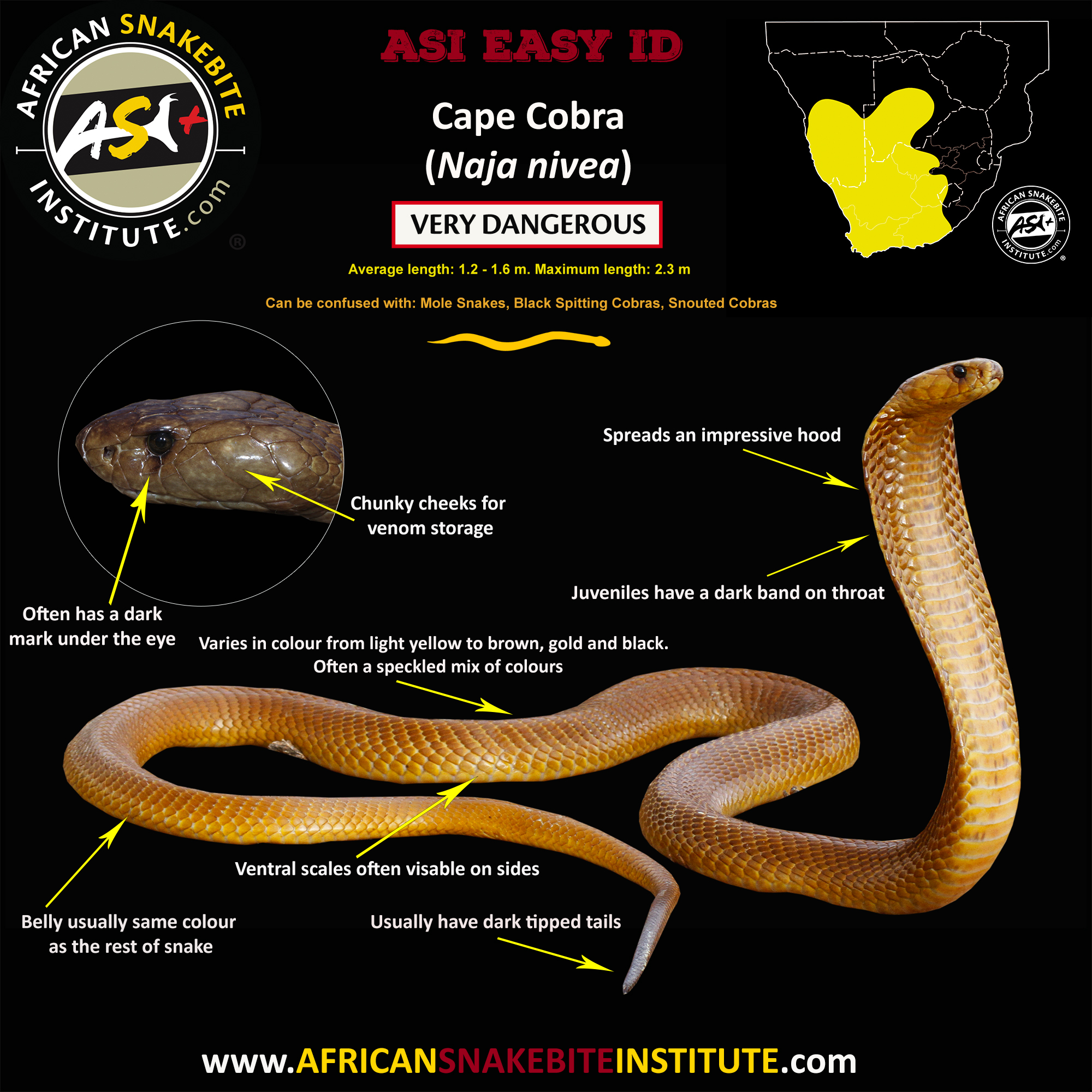They are highly venomous. If the threat remains motionless, the snake will quickly attempt to escape, but at any sign of movement will adopt its defensive posture again.
The Cape cobra is regarded as one of the most dangerous species of cobra in all of Africa, by virtue of its potent venom and frequent occurrence around houses. The venom of this snake tends to be thick and syrupy in consistency and dries into shiny pale flakes, not unlike yellow sugar. The Cape cobra's venom is made up of potent postsynaptic neurotoxins and might also contain cardiotoxins, that affect the respiratory system, nervous system, and the heart.
The Cape cobra is a medium-sized species of cobra. Mature specimens are typically about 1.2 to 1.4 metres (3.9 to 4.6 ft) long, but may grow up to 1.6 metres (5.2 ft) in length. Males are slightly larger than females. The longest specimen on record was a male from Aus, Namibia and measured 1.88 metres (6.2 ft) long.
Cape cobras vary widely in colouration, from yellow through golden brown to dark brown and even black. In addition, individuals show a varying degree of black or pale stippling and blotches, and although colour and marking are geographically related, it is also possible to observe virtually all colour varieties at one location. For example, the Kalahari Desert specimens in Botswana and Namibia are usually more consistently yellow than the more southerly populations.
The preferred habitat of the species is fynbos, bushveld, karoo scrubland, arid savanna, the Namib desert and the Kalahari desert. It often inhabits rodent burrows, abandoned termite mounds and, in arid regions, rock crevices.
The Cape cobra is a diurnal species and actively forages throughout the day.Sources:
(*) https://en.wikipedia.org/wiki/Cape_cobra
(*) https://www.africansnakebiteinstitute.com/articles/cobras-of-southern-africa/
(*) https://capesnakeconservation.com/cape-cobra/
(*) https://snake-facts.weebly.com/cape-cobra.html
The Cape cobra is regarded as one of the most dangerous species of cobra in all of Africa, by virtue of its potent venom and frequent occurrence around houses. The venom of this snake tends to be thick and syrupy in consistency and dries into shiny pale flakes, not unlike yellow sugar. The Cape cobra's venom is made up of potent postsynaptic neurotoxins and might also contain cardiotoxins, that affect the respiratory system, nervous system, and the heart.
By Marius Burger - http://www.savp.co.za/Venomous/slides/Cape%20Cobra.html, CC BY-SA 3.0, https://commons.wikimedia.org/w/index.php?curid=52494687
Snake Slang
By Bjoertvedt - Own work, CC BY-SA 3.0, https://commons.wikimedia.org/w/index.php?curid=24274207
The species is diurnal and is a feeding generalist, preying on a number of different species and carrion.
The Cape cobra is a medium-sized species of cobra. Mature specimens are typically about 1.2 to 1.4 metres (3.9 to 4.6 ft) long, but may grow up to 1.6 metres (5.2 ft) in length. Males are slightly larger than females. The longest specimen on record was a male from Aus, Namibia and measured 1.88 metres (6.2 ft) long.
Cape cobras vary widely in colouration, from yellow through golden brown to dark brown and even black. In addition, individuals show a varying degree of black or pale stippling and blotches, and although colour and marking are geographically related, it is also possible to observe virtually all colour varieties at one location. For example, the Kalahari Desert specimens in Botswana and Namibia are usually more consistently yellow than the more southerly populations.
The preferred habitat of the species is fynbos, bushveld, karoo scrubland, arid savanna, the Namib desert and the Kalahari desert. It often inhabits rodent burrows, abandoned termite mounds and, in arid regions, rock crevices.
The Cape cobra is a diurnal species and actively forages throughout the day.Sources:
(*) https://en.wikipedia.org/wiki/Cape_cobra
(*) https://www.africansnakebiteinstitute.com/articles/cobras-of-southern-africa/
(*) https://capesnakeconservation.com/cape-cobra/
(*) https://snake-facts.weebly.com/cape-cobra.html

.jpg)
